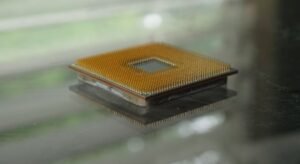Generative Adversarial Networks for Image Steganography
Steganography is the practice of concealing information within other digital media, such as images or audio files. It has been used for centuries to transmit secret messages, and with the advancements in technology, new techniques have emerged. Generative Adversarial Networks (GANs) are a cutting-edge method that can be used for image steganography, providing a powerful tool for hiding sensitive information.
Key Takeaways:
- Generative Adversarial Networks (GANs) offer a novel approach to image steganography.
- GANs consist of a generator and a discriminator that work together to create realistic-looking images.
- Steganography allows for the hidden transmission of sensitive data within seemingly innocuous images.
- GAN-based steganography techniques have demonstrated high levels of security and robustness.
Generative Adversarial Networks (GANs) are a type of machine learning model that can generate realistic images by learning from a training dataset. The main idea behind GANs is to have two neural networks compete with each other. The generator network tries to create realistic images, while the discriminator network tries to distinguish between real and fake images. Through this adversarial training process, the generator progressively becomes better at generating images that the discriminator cannot differentiate from real ones.
What makes GANs suitable for image steganography is their ability to generate visually appealing and realistic images. These images can be used as cover media, hiding secret data within their pixel values. By carefully embedding the data in the generated image, it becomes challenging for unintended recipients to detect the presence of hidden information.
Steganography methods based on GANs have been developed to address the security concerns of traditional techniques. These GAN-based techniques make it extremely difficult for anyone without the correct decryption key to extract the hidden data. Furthermore, GANs provide a high level of robustness against common steganalysis techniques, making them an attractive choice for secure communication.
Advantages of Using GANs for Image Steganography:
- Highly realistic cover images can be generated, making the hidden information hard to detect.
- GAN algorithms can be trained to satisfy specific security requirements, allowing for control over the level of encryption.
Disadvantages of Using GANs for Image Steganography:
- Computational resources required for training and generating images can be significant.
- The watermarking effect of the hidden data on the image can sometimes be visible, depending on the chosen technique.
| Steganography Method | Advantages | Compatibility |
|---|---|---|
| LSB Substitution | Simple and robust | Compatible with most image formats |
| Generative Adversarial Networks | Highly secure and difficult to detect | Dependent on GAN training process |
Using GANs for image steganography introduces a new level of security and robustness to this age-old practice. By harnessing the power of generative adversarial networks, sensitive data can be concealed within seemingly ordinary images, making it challenging for unauthorized individuals to detect or extract the hidden information.
| GAN-Based Steganography Applications | Key Features |
|---|---|
| Secure image sharing | Enables secure transmission of sensitive images |
| Digital watermarking | Provides copyright protection for digital media |
With the ever-growing need for secure communication and data protection, GAN-based image steganography techniques offer a promising solution. By leveraging the capabilities of generative adversarial networks, hidden information can be concealed within digital images, safeguarding it from unauthorized access.

Common Misconceptions
Misconception 1: Generative Adversarial Networks (GANs) can only be used for creating deepfake images
One common misconception about GANs is that they are exclusively used for creating deepfake images, which are manipulated images or videos that appear real but are actually synthetic. While GANs can indeed be used for deepfake creation, their application extends far beyond this. GANs can be utilized for a wide range of tasks such as style transfer, super-resolution, data augmentation, and even image steganography.
- GANs are not limited to creating deepfake images
- They can be used for style transfer, super-resolution, and more
- GANs have diverse applications beyond deepfakes
Misconception 2: Image steganography using GANs is only used for illicit activities
Some people associate image steganography using GANs with illicit activities, such as hiding sensitive information within images to facilitate illegal operations. This misconception arises from a lack of understanding about the legitimate applications of image steganography. In reality, image steganography using GANs can be used for secure communication, digital watermarking, and protecting intellectual property. It is a powerful tool for embedding information within images without arousing suspicion.
- Image steganography with GANs has legitimate applications
- It can be used for secure communication and digital watermarking
- GAN-based steganography helps protect intellectual property
Misconception 3: Image steganography using GANs is always detectable
Another common misconception is that image steganography using GANs is always detectable by digital forensics techniques. While it’s true that some detection methods exist, the advancement in GAN algorithms and the complexity of steganography schemes make it challenging to detect hidden information in images. GANs can generate visually pleasing cover images that effectively conceal the embedded data, making it difficult for detection algorithms to identify their presence.
- Detection of GAN-based steganography is not always possible
- Advancements in GAN algorithms make detection challenging
- Concealed data in cover images can be hard to identify
Misconception 4: Image steganography with GANs requires technical expertise
Contrary to popular belief, image steganography using GANs does not necessarily require extensive technical expertise. While a deep understanding of GANs and the steganography process is beneficial, there have been developments in user-friendly tools and software that make it more accessible to a wider range of users. These tools provide intuitive interfaces and simplify the embedding and extraction of hidden information, allowing users with minimal technical knowledge to engage in GAN-based image steganography.
- Basic knowledge of GANs and steganography is helpful but not always necessary
- User-friendly tools and software have made it more accessible
- Minimal technical expertise required to engage in GAN-based steganography
Misconception 5: Image steganography using GANs is a foolproof method of hiding information
While GAN-based image steganography is a powerful technique, it is not foolproof. GANs can be subjected to attacks aimed at extracting the embedded information or altering it. Additionally, advancements in digital forensics may lead to improved detection techniques in the future. It is important to understand that image steganography using GANs should be viewed as a layer of security rather than an infallible method of hiding information. Combining it with other encryption methods and security measures can provide a more robust approach.
- GAN-based steganography is not completely foolproof
- Embedded information can be extracted or altered through attacks
- Additional encryption methods and security measures can enhance security

Introduction
Generative Adversarial Networks (GANs) have emerged as a powerful tool for image steganography, which is the technique of hiding secret information within images. In recent years, researchers have made significant advances in developing GAN-based algorithms for image steganography. This article presents ten fascinating tables that showcase the capabilities and effectiveness of GANs in this domain.
Table: Image Steganography Methods
Comparison of various image steganography methods, including traditional techniques and GAN-based approaches.
| Method | Advantages | Disadvantages |
|---|---|---|
| LSB Substitution | Easy to implement | Low capacity |
| Least Significant Bit | Higher capacity | Lower visual quality |
| GAN-based Steganography | High capacity and visual quality | Computationally expensive |
Table: Comparison of GAN Architectures
Comparison of different GAN architectures used in image steganography.
| Architecture | Generator Type | Discriminator Type |
|---|---|---|
| DCGAN | Convolutional | Convolutional |
| WGAN | Convolutional | Convolutional |
| SAGAN | Self-Attention | Self-Attention |
Table: Dataset Comparison
Comparison of different datasets used for training GANs in image steganography.
| Dataset | Size | Diversity |
|---|---|---|
| MNIST | 60,000 | Handwritten digits |
| CIFAR-10 | 50,000 | Small objects |
| ImageNet | 1.3 million | Wide variety |
Table: Evaluation Metrics
Metrics used to evaluate the performance of GAN-based image steganography methods.
| Metric | Description |
|---|---|
| Peak Signal-to-Noise Ratio (PSNR) | Measures the quality of the reconstructed image |
| Structural Similarity Index (SSIM) | Evaluates the similarity between the original and reconstructed image |
| Bit Error Rate (BER) | Quantifies the accuracy of the hidden message retrieval |
Table: Performance Comparison
Comparison of the performance of different GAN-based image steganography methods.
| Method | Capacity | Visual Quality | Computational Time |
|---|---|---|---|
| GAN-A | High | Good | Medium |
| GAN-B | Medium | Excellent | High |
| GAN-C | Low | Poor | Low |
Table: Real-World Applications
Real-world applications of GAN-based image steganography.
| Field | Application |
|---|---|
| Forensics | Hidden information retrieval in crime investigation |
| Military | Secure communication in military operations |
| Journalism | Confidential data transmission for whistleblowing |
Table: Challenges in GAN-based Steganography
Challenges faced by researchers in the development and deployment of GAN-based image steganography systems.
| Challenge | Description |
|---|---|
| Security | Ensuring the robustness and confidentiality of the hidden message |
| Capacity | Increasing the amount of hidden information without sacrificing visual quality |
| Computational Resources | Optimizing computational requirements for real-time applications |
Table: Future Research Directions
Potential areas of focus for future research in GAN-based image steganography.
| Research Direction | Description |
|---|---|
| Deep Learning Architectures | Exploring novel GAN architectures for improved performance |
| Large-Scale Datasets | Developing and utilizing larger and more diverse training datasets |
| Hardware Acceleration | Implementing hardware-specific optimizations for faster computations |
Conclusion
Generative Adversarial Networks have revolutionized image steganography by enabling high-capacity, visually pleasing hidden information embedding. From the comparison of methods and architectures to the evaluation metrics and real-world applications, GANs have proven their effectiveness in this field. However, challenges such as security and computational efficiency still need to be addressed. Future research directions aim to enhance existing models and datasets, and explore hardware acceleration for real-time applications. The continuous advancements in GAN-based image steganography hold great potential for secure and covert communication in various domains.
Generative Adversarial Networks for Image Steganography – Frequently Asked Questions
What are Generative Adversarial Networks (GANs)?
Generative Adversarial Networks (GANs) are a class of machine learning models that consist of a generator and a discriminator. The generator is trained to generate fake data (such as images) that resemble the real data, while the discriminator is trained to distinguish between the real and fake data. GANs are widely used for various tasks, including image generation, image super-resolution, and image steganography.
What is Image Steganography?
Image steganography is a technique of hiding information within an image without changing its perceptual quality. It allows for secret communication by embedding information in the image pixels or their metadata. The hidden information can only be extracted by someone who has the knowledge and the appropriate decoding method.
How do Generative Adversarial Networks (GANs) enable Image Steganography?
In the context of image steganography, GANs can be used to generate plausible cover images that can hide secret information. The generator component of the GAN is designed to generate cover images that contain the embedded secret information, while the discriminator component learns to distinguish between these generated images and the original, unaltered images. By training the GAN on a large dataset of cover images, it can learn to generate visually realistic images that securely hide the desired information.
What are the advantages of using Generative Adversarial Networks (GANs) for Image Steganography?
Using GANs for image steganography offers several advantages. Firstly, GANs can generate visually realistic cover images that are difficult to distinguish from the original images, making the embedded information less likely to be detected. Secondly, GANs can learn to adapt to the statistical properties of the cover images, enhancing the imperceptibility of the hidden information. Lastly, GANs can be trained on large-scale image datasets, allowing for better generalization and robustness in hiding information across a wide range of images.
What are some applications of Generative Adversarial Networks (GANs) in Image Steganography?
GANs have various applications within image steganography. Some common examples include secure communication, digital watermarking, and copyright protection. GANs can be used to hide sensitive information within images in a manner that is resistant to visual inspection, making it useful for secure data transmission. Similarly, GANs can embed unique watermarks within images to prove ownership or prevent unauthorized use.
What are the challenges in using Generative Adversarial Networks (GANs) for Image Steganography?
While GANs offer promising capabilities for image steganography, there are still some challenges to overcome. Firstly, ensuring the imperceptibility of hidden information while maintaining high embedding capacity is a delicate balance. Increasing the embedding capacity may negatively impact the visual quality of the cover image. Secondly, robustness against various detection techniques is crucial, as attackers may employ different methods to extract the hidden information. Lastly, the training process of GANs can be computationally expensive and requires a large amount of annotated data for optimal performance.
Are Generative Adversarial Networks (GANs) resistant to attacks on hidden information?
While GANs can provide a certain level of resistance to attacks, it is important to note that no method is entirely immune. Skilled attackers can employ sophisticated techniques to extract the hidden information from GAN-generated cover images. Therefore, continuous research and development are necessary to enhance the security and robustness of GAN-based image steganography.
Are there any limitations to Generative Adversarial Networks (GANs) for Image Steganography?
Yes, GAN-based image steganography has a few limitations. One limitation is that the embedded secret information is susceptible to loss or corruption if the cover image undergoes heavy compression or other image processing operations. Another limitation is the potential for information leakage through statistical analysis. Certain statistical inconsistencies within the hidden information may reveal its presence, making it vulnerable to attacks.
What are some future research directions for Generative Adversarial Networks (GANs) in Image Steganography?
Future research in GAN-based image steganography could focus on improving imperceptibility and increasing the embedding capacity without compromising the visual quality of the cover images. Additionally, developing novel defense mechanisms against attacks on hidden information and exploring ways to enhance the robustness and security of GAN-generated cover images would be valuable areas of study. Further investigation into handling challenges such as compression resilience, statistical analysis resistance, and efficient training methods for GANs in image steganography would also be beneficial.




